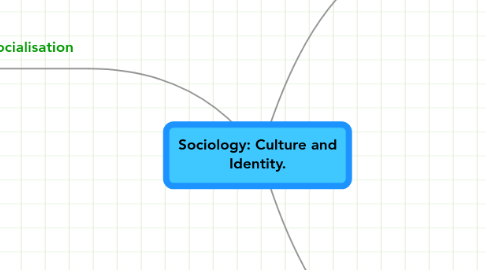
1. Socialisation
1.1. Primary socialisation
1.1.1. family
1.1.2. crucial to a person's development, so that children learn how to interact and communicate with others.
1.1.3. recognise that they have particular social roles
1.1.3.1. e.g son, daughter, brother etc
1.1.4. allows children to become aware of themselves as "social beings"
1.1.5. acquire human skills such as emotional responses to certain situations
1.1.5.1. love, sadness, humour
1.1.6. necessary skills to empathise with others
1.2. FERAL CHILDREN
1.2.1. good example of when children are denied to human contact whilst growing up, so they tend to behave like their animal foster parents
1.2.1.1. e.g walking on all fours, being unable to talk, being aggressive.
1.3. social control
1.3.1. sanctions used to reinforce and reward socially approved behaviour or to punish and discipline deviant behaviour
1.3.1.1. Postive Informal
1.3.1.1.1. e.g teacher praising a student
1.3.1.2. positive formal
1.3.1.2.1. e.g getting an award
1.3.1.3. negative informal
1.3.1.3.1. e.g being told off
1.3.1.4. negative formal
1.3.1.4.1. e.g detention
1.3.1.5. informal
1.3.1.5.1. institutions that are not set specifically to enforce rules, although they serve to do so.
1.3.1.5.2. functionalist view: learn to live in harmony with others
1.3.1.5.3. marxist view:teach us not to challenge authority
1.3.1.5.4. feminist view: teach us to behave in ways acceptable to our gender.
1.3.1.6. formal
1.3.1.6.1. institutions set up to partly or completely enforce rules
1.3.1.6.2. functionalist view: schools and police apply the same sanctions to everyone
1.3.1.6.3. marxist view: schools and police apply more social control to working class and some ethnic groups may be treated less fairly than others by the criminal justice system
1.3.1.6.4. feminist view: schools and police apply formal sanctions differently to different genders.
1.4. secondary socialisation.
1.4.1. builds onto primary socialisation and is carried out by various institutions.
1.4.2. Education
1.4.2.1. functionalist view: school promotes consensus by teaching norms and values. Also, children learn to value belonging to a large group through things such as uniforms and assembley.
1.4.2.2. marxist view: operates a HIDDEN CURRICULUM that socialises pupils into ruling class cultures and encourages them to accept exploitation.
1.4.2.2.1. Bowles and Gintis
1.4.2.2.2. hidden curriculum - doing as your told and not questioning authority.
1.4.3. Peer groups
1.4.3.1. similar social status
1.4.3.2. influence norms and values
1.4.3.3. towards conformity or deviance
1.4.3.3.1. youth subcultures sometimes encourage deviant behaviour
1.4.4. Religion
1.4.4.1. provides social norms and values.
1.4.5. Mass Media
1.4.5.1. powerful in shaping norms and values in the audience.
1.4.5.2. Replaced religion in secondary socialisation.
1.4.5.2.1. Althusser
1.4.6. Workplace
1.4.6.1. involves learning the norms and values that enable people to join the world of work
1.4.6.1.1. e.g being on time, obeying the boss
2. Culture.
2.1. High culture
2.1.1. cultural products and activities that are defined as superior in their creativity to those that make up mass or popular culture.
2.1.1.1. e.g opera, ballet, art
2.2. Folk culture.
2.2.1. traditional cultural products and activities that originate with ordinary people and are rooted in pre-industrial societies.
2.2.1.1. e.g morris dancing
2.3. Mass Culture.
2.3.1. cultural products that are consumed by large numbers of people - marxist view of exploitation and brainwashing.
2.4. Popular culture.
2.4.1. cultural products enjoyed by large numbers of people
2.4.1.1. e.g pop music, films, television.
2.5. Functionalist view:
2.5.1. Shared cultural values, goals and norms leading to value consensus which unites societies members, allowing it to function.
2.5.1.1. Durkheim.
2.5.2. pre-industrial societies
2.5.2.1. social institutions role to socialise individuals into value consensus
2.5.3. modern societies
2.5.3.1. urbanisation and industrialisation have the potential to undermine value consensus and cultural conformity because we experience more choice in our beliefs and actions and thus more opportunity to be individuals.
2.5.3.1.1. potentially disruptive because people could become confused about what values, rules etc they should live by.
2.6. Marxist view:
2.6.1. characterised by class inequality and conflict. The bourgeoisie own and control the proletariat in order to make greater wealth.
2.6.1.1. Karl Marx
2.6.2. idealogy: the cultural ideas and values that are dominated by ruling class culture.
2.6.2.1. social institutions socialise the working class to accept the ruling class culture and therefore see their low status as normal.
2.7. Diversity and Subcultures.
2.7.1. Functionalism and marxism overstate the sharing of culture and fail to notice that modern societies are characterised by cultural diversity.
2.7.2. Cultures are fragmented into competing subcultures
2.7.2.1. social groups based on ethnicity, class etc subscribe to societies values and norms, but also their own cultural ones unique to them.
2.7.2.1.1. deviant?
2.8. globalisation
3. Social Class
3.1. upper class
3.1.1. old school-tie network
3.1.1.1. a system of economic and social supports maintained by ex-public-school boys in adulthood.
3.1.2. conservative
3.1.2.1. belief in traditional ways of doing things
3.1.3. wealthy extended families, with common background such as expensive public schools.
3.1.4. high culture activities - ballet, opera, hunting etc.
